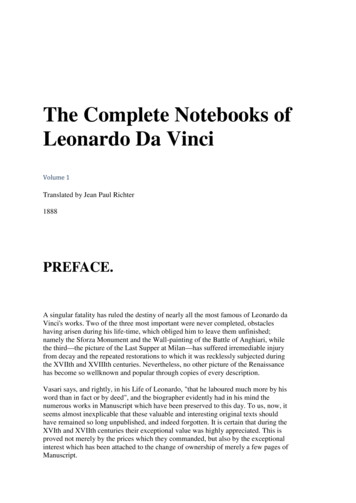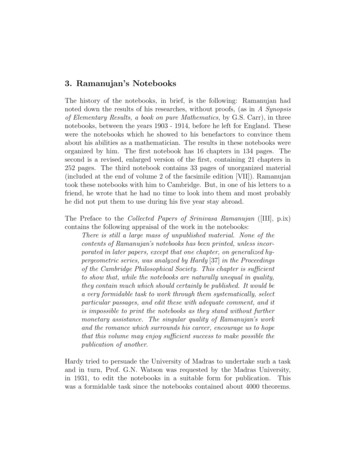
Transcription
The Complete Notebooks ofLeonardo Da VinciVolume 1Translated by Jean Paul Richter1888PREFACE.A singular fatality has ruled the destiny of nearly all the most famous of Leonardo daVinci's works. Two of the three most important were never completed, obstacleshaving arisen during his life-time, which obliged him to leave them unfinished;namely the Sforza Monument and the Wall-painting of the Battle of Anghiari, whilethe third—the picture of the Last Supper at Milan—has suffered irremediable injuryfrom decay and the repeated restorations to which it was recklessly subjected duringthe XVIIth and XVIIIth centuries. Nevertheless, no other picture of the Renaissancehas become so wellknown and popular through copies of every description.Vasari says, and rightly, in his Life of Leonardo, "that he laboured much more by hisword than in fact or by deed", and the biographer evidently had in his mind thenumerous works in Manuscript which have been preserved to this day. To us, now, itseems almost inexplicable that these valuable and interesting original texts shouldhave remained so long unpublished, and indeed forgotten. It is certain that during theXVIth and XVIIth centuries their exceptional value was highly appreciated. This isproved not merely by the prices which they commanded, but also by the exceptionalinterest which has been attached to the change of ownership of merely a few pages ofManuscript.
That, notwithstanding this eagerness to possess the Manuscripts, their contentsremained a mystery, can only be accounted for by the many and great difficultiesattending the task of deciphering them. The handwriting is so peculiar that it requiresconsiderable practice to read even a few detached phrases, much more to solve withany certainty the numerous difficulties of alternative readings, and to master the senseas a connected whole. Vasari observes with reference to Leonardos writing: "he wrotebackwards, in rude characters, and with the left hand, so that any one who is notpractised in reading them, cannot understand them". The aid of a mirror in readingreversed handwriting appears to me available only for a first experimental reading.Speaking from my own experience, the persistent use of it is too fatiguing andinconvenient to be practically advisable, considering the enormous mass ofManuscripts to be deciphered. And as, after all, Leonardo's handwriting runsbackwards just as all Oriental character runs backwards—that is to say from right toleft—the difficulty of reading direct from the writing is not insuperable. This obviouspeculiarity in the writing is not, however, by any means the only obstacle in the wayof mastering the text. Leonardo made use of an orthography peculiar to himself; hehad a fashion of amalgamating several short words into one long one, or, again, hewould quite arbitrarily divide a long word into two separate halves; added to this thereis no punctuation whatever to regulate the division and construction of the sentences,nor are there any accents—and the reader may imagine that such difficulties werealmost sufficient to make the task seem a desperate one to a beginner. It is thereforenot surprising that the good intentions of some of Leonardo s most reverent admirersshould have failed.Leonardos literary labours in various departments both of Art and of Science werethose essentially of an enquirer, hence the analytical method is that which he employsin arguing out his investigations and dissertations. The vast structure of his scientifictheories is consequently built up of numerous separate researches, and it is much to belamented that he should never have collated and arranged them. His love for detailedresearch—as it seems to me—was the reason that in almost all the Manuscripts, thedifferent paragraphs appear to us to be in utter confusion; on one and the same page,observations on the most dissimilar subjects follow each other without anyconnection. A page, for instance, will begin with some principles of astronomy, or themotion of the earth; then come the laws of sound, and finally some precepts as tocolour. Another page will begin with his investigations on the structure of theintestines, and end with philosophical remarks as to the relations of poetry to painting;and so forth.Leonardo himself lamented this confusion, and for that reason I do not think that thepublication of the texts in the order in which they occur in the originals would at allfulfil his intentions. No reader could find his way through such a labyrinth; Leonardohimself could not have done it.Added to this, more than half of the five thousand manuscript pages which nowremain to us, are written on loose leaves, and at present arranged in a manner which
has no justification beyond the fancy of the collector who first brought them togetherto make volumes of more or less extent. Nay, even in the volumes, the pages of whichwere numbered by Leonardo himself, their order, so far as the connection of the textswas concerned, was obviously a matter of indifference to him. The only point heseems to have kept in view, when first writing down his notes, was that eachobservation should be complete to the end on the page on which it was begun. Theexceptions to this rule are extremely few, and it is certainly noteworthy that we find insuch cases, in bound volumes with his numbered pages, the written observations: "turnover", "This is the continuation of the previous page", and the like. Is not thissufficient to prove that it was only in quite exceptional cases that the writer intendedthe consecutive pages to remain connected, when he should, at last, carry out the oftenplanned arrangement of his writings?What this final arrangement was to be, Leonardo has in most cases indicated withconsiderable completeness. In other cases this authoritative clue is wanting, but thedifficulties arising from this are not insuperable; for, as the subject of the separateparagraphs is always distinct and well defined in itself, it is quite possible to constructa well-planned whole, out of the scattered materials of his scientific system, and I mayventure to state that I have devoted especial care and thought to the due execution ofthis responsible task.The beginning of Leonardo's literary labours dates from about his thirty-seventh year,and he seems to have carried them on without any serious interruption till his death.Thus the Manuscripts that remain represent a period of about thirty years. Within thisspace of time his handwriting altered so little that it is impossible to judge from it ofthe date of any particular text. The exact dates, indeed, can only be assigned to certainnote-books in which the year is incidentally indicated, and in which the order of theleaves has not been altered since Leonardo used them. The assistance these afford fora chronological arrangement of the Manuscripts is generally self evident. By this clueI have assigned to the original Manuscripts now scattered through England, Italy andFrance, the order of their production, as in many matters of detail it is highlyimportant to be able to verify the time and place at which certain observations weremade and registered. For this purpose the Bibliography of the Manuscripts given at theend of Vol. II, may be regarded as an Index, not far short of complete, of all Leonardos literary works now extant. The consecutive numbers (from 1 to 1566) at the head ofeach passage in this work, indicate their logical sequence with reference to thesubjects; while the letters and figures to the left of each paragraph refer to the originalManuscript and number of the page, on which that particular passage is to be found.Thus the reader, by referring to the List of Manuscripts at the beginning of Volume I,and to the Bibliography at the end of Volume II, can, in every instance, easilyascertain, not merely the period to which the passage belongs, but also exactly whereit stood in the original document. Thus, too, by following the sequence of the numbersin the Bibliographical index, the reader may reconstruct the original order of theManuscripts and recompose the various texts to be found on the original sheets—somuch of it, that is to say, as by its subject-matter came within the scope of this work. Itmay, however, be here observed that Leonardo s Manuscripts contain, besides the
passages here printed, a great number of notes and dissertations on Mechanics,Physics, and some other subjects, many of which could only be satisfactorily dealtwith by specialists. I have given as complete a review of these writings as seemednecessary in the Bibliographical notes.In 1651, Raphael Trichet Dufresne, of Paris, published a selection from Leonardo'swritings on painting, and this treatise became so popular that it has since beenreprinted about two-and-twenty times, and in six different languages. But none ofthese editions were derived from the original texts, which were supposed to have beenlost, but from early copies, in which Leonardo's text had been more or less mutilated,and which were all fragmentary. The oldest and on the whole the best copy ofLeonardo's essays and precepts on Painting is in the Vatican Library; this has beentwice printed, first by Manzi, in 1817, and secondly by Ludwig, in 1882. Still, thisancient copy, and the published editions of it, contain much for which it would be rashto hold Leonardo responsible, and some portions—such as the very important rules forthe proportions of the human figure—are wholly wanting; on the other hand theycontain passages which, if they are genuine, cannot now be verified from any originalManuscript extant. These copies, at any rate neither give us the original order of thetexts, as written by Leonardo, nor do they afford any substitute, by connecting themon a rational scheme; indeed, in their chaotic confusion they are anything rather thansatisfactory reading. The fault, no doubt, rests with the compiler of the Vatican copy,which would seem to be the source whence all the published and extensively knowntexts were derived; for, instead of arranging the passages himself, he was satisfiedwith recording a suggestion for a final arrangement of them into eight distinct parts,without attempting to carry out his scheme. Under the mistaken idea that this plan ofdistribution might be that, not of the compiler, but of Leonardo himself, the variouseditors, down to the present day, have very injudiciously continued to adopt thisorder—or rather disorder.I, like other enquirers, had given up the original Manuscript of the Trattato dellaPittura for lost, till, in the beginning of 1880, I was enabled, by the liberality of LordAshburnham, to inspect his Manuscripts, and was so happy as to discover among themthe original text of the best-known portion of the Trattato in his magnificent library atAshburnham Place. Though this discovery was of a fragment only—but aconsiderable fragment—inciting me to further search, it gave the key to the mysterywhich had so long enveloped the first origin of all the known copies of the Trattato.The extensive researches I was subsequently enabled to prosecute, and the results ofwhich are combined in this work, were only rendered possible by the unrestrictedpermission granted me to investigate all the Manuscripts by Leonardo dispersedthroughout Europe, and to reproduce the highly important original sketches theycontain, by the process of "photogravure". Her Majesty the Queen graciously accordedme special permission to copy for publication the Manuscripts at the Royal Library atWindsor. The Commission Centrale Administrative de l'Institut de France, Paris, gaveme, in the most liberal manner, in answer to an application from Sir FredericLeighton, P. R. A., Corresponding member of the Institut, free permission to work forseveral months in their private collection at deciphering the Manuscripts preserved
there. The same favour which Lord Ashburnham had already granted me wasextended to me by the Earl of Leicester, the Marchese Trivulsi, and the Curators of theAmbrosian Library at Milan, by the Conte Manzoni at Rome and by other privateowners of Manuscripts of Leonardo's; as also by the Directors of the Louvre at Paris;the Accademia at Venice; the Uffizi at Florence; the Royal Library at Turin; and theBritish Museum, and the South Kensington Museum. I am also greatly indebted to theLibrarians of these various collections for much assistance in my labours; and moreparticularly to Monsieur Louis Lalanne, of the Institut de France, the Abbate Ceriani,of the Ambrosian Library, Mr. Maude Thompson, Keeper of Manuscripts at theBritish Museum, Mr. Holmes, the Queens Librarian at Windsor, the Revd Vere Bayne,Librarian of Christ Church College at Oxford, and the Revd A. Napier, Librarian tothe Earl of Leicester at Holkham Hall.In correcting the Italian text for the press, I have had the advantage of valuable advicefrom the Commendatore Giov. Morelli, Senatore del Regno, and from Signor GustavoFrizzoni, of Milan. The translation, under many difficulties, of the Italian text intoEnglish, is mainly due to Mrs. R. C. Bell; while the rendering of several of the mostpuzzling and important passages, particularly in the second half of Vol. I, I owe to theindefatigable interest taken in this work by Mr. E. J. Poynter R. A. Finally I mustexpress my thanks to Mr. Alfred Marks, of Long Ditton, who has most kindly assistedme throughout in the revision of the proof sheets.The notes and dissertations on the texts on Architecture in Vol. III owe to my friend Baron Henri de Geymuller, of Paris.I may further mention with regard to the illustrations, that the negatives for theproduction of the "photo-gravures" by Monsieur Dujardin of Paris were all takendirect from the originals.It is scarcely necessary to add that most of the drawings here reproduced in facsimilehave never been published before. As I am now, on the termination of a work ofseveral years' duration, in a position to review the general tenour of Leonardoswritings, I may perhaps be permitted to add a word as to my own estimate of the valueof their contents. I have already shown that it is due to nothing but a fortuitoussuccession of unfortunate circumstances, that we should not, long since, have knownLeonardo, not merely as a Painter, but as an Author, a Philosopher, and a Naturalist.There can be no doubt that in more than one department his principles and discoverieswere infinitely more in accord with the teachings of modern science, than with theviews of his contemporaries. For this reason his extraordinary gifts and merits are farmore likely to be appreciated in our own time than they could have been during thepreceding centuries. He has been unjustly accused of having squandered his powers,by beginning a variety of studies and then, having hardly begun, throwing them aside.The truth is that the labours of three centuries have hardly sufficed for the elucidationof some of the problems which occupied his mighty mind.
Alexander von Humboldt has borne witness that "he was the first to start on the roadtowards the point where all the impressions of our senses converge in the idea of theUnity of Nature" Nay, yet more may be said. The very words which are inscribed onthe monument of Alexander von Humboldt himself, at Berlin, are perhaps the mostappropriate in which we can sum up our estimate of Leonardo's genius:"Majestati naturae par ingenium."LONDON, April 1883.F. P. R.CONTENTS OF VOLUME I.PROLEGOMENA AND GENERALINTRODUCTION TO THE BOOK ONPAINTINGClavis Sigillorum and Index of Manuscripts.—The author's intention to publish hisMSS. (1).—The preparation of the MSS. for publication (2).—Admonition to readers(3).—The disorder in the MSS. (4).—Suggestions for the arrangement of MSS.treating of particular subjects (5—8).—General introductions to the book on painting(9—13).—The plan of the book on painting (14—17).—The use of the book onpainting (18).—Necessity of theoretical knowledge (19, 20).—The function of the eye(21—23).—Variability of the eye (24).—Focus of sight (25).—Differences ofperception by one eye and by both eyes (26—29).—The comparative size of theimage depends on the amount of light (30—39).
II.LINEAR PERSPECTIVEGeneral remarks on perspective (40—41).—The elements of perspective:—of thepoint (42—46).—Of the line (47—48).—The nature of the outline (49).—Definitionof perspective (50).—The perception of the object depends on the direction of the eye(51).—Experimental proof of the existence of the pyramid of sight (52—55).—Therelations of the distance point to the vanishing point (55—56).—How to measure thepyramid of vision (57).—The production of the pyramid of vision (58—64).—Proofby experiment (65—66).—General conclusions (67).—That the contrary is impossible(68).—A parallel case (69).—The function of the eye, as explained by the cameraobscura (70—71).—The practice of perspective (72—73).—Refraction of the raysfalling upon the eye (74—75).—The inversion of the images (76).—The intersectionof the rays (77—82).—Demonstration of perspective by means of a vertical glassplane (83—85.)—The angle of sight varies with the distance (86—88).—Oppositepyramids in juxtaposition (89).—On simple and complex perspective (90).—Theproper distance of objects from the eye (91—92).—The relative size of objects withregard to their distance from the eye (93—98).—The apparent size of objects dennedby calculation (99—106).—On natural perspective (107—109).III.SIX BOOKS ON LIGHT AND SHADEGENERAL INTRODUCTION.—Prolegomena (110).—Scheme of the books on lightand shade (111).—Different principles and plans of treatment (112—116).—Differentsorts of light (117—118).—Definition of the nature of shadows (119—122).—Of thevarious kinds of shadows (123—125).—Of the various kinds of light (126—127).—General remarks (128—129).—FIRST BOOK ON LIGHT AND SHADE.—On thenature of light (130—131).—The difference between light and lustre (132—135).—The relations of luminous to illuminated bodies (136). —Experiments on the relationof light and shadow within a room (137—140).—Light and shadow with regard to theposition of the eye (141—145).—The law of the incidence of light (146—147).—SECOND BOOK ON LIGHT AND SHADE.—Gradations of strength in the shadows(148—149).—On the intensity of shadows as dependent on the distance from the light(150—152).—On the proportion of light and shadow (153—157).—THIRD BOOKON LIGHT AND SHADE.—Definition of derived shadow (158—159).—Differentsorts of derived shadows (160—162).—On the relation of derived and primaryshadow (163—165).—On the shape of derived shadows (166—174).—On the relativeintensity of derived shadows (175—179).—Shadow as produced by two lights ofdifferent size (180—181).—The effect of light at different distances (182).—Furthercomplications in the derived shadows (183—187).—FOURTH BOOK ON LIGHTAND SHADE.—On the shape of cast shadows (188—191).—On the outlines of castshadows (192—195).—On the relative size of cast shadows (196. 197).—Effects oncast shadows by the tone of the back ground (198).—A disputed proposition (199).—
On the relative depth of cast shadows (200—202).—FIFTH BOOK ON LIGHT ANDSHADE.—Principles of reflection (203. 204).—On reverberation (205).—Reflectionon water (206. 207).—Experiments with the mirror (208—210).—Appendix:—Onshadows in movement (211—212).—SIXTH BOOK ON LIGHT AND SHADE.—The effect of rays passing through holes (213. 214).—On gradation of shadows (215.216).—On relative proportion of light and shadows (216—221).IV.PERSPECTIVE OF DISAPPEARANCEDefinition (222. 223).—An illustration by experiment (224).—A guiding rule (225).—-An experiment (226).—On indistinctness at short distances (227—231).—Onindistinctness at great distances (232—234).—The importance of light and shade inthe Prospettiva de' perdimenti (235—239).—The effect of light or dark backgroundson the apparent size of objects (240—250).—Propositions on Prospettiva de'perdimenti from MS. C. (250—262).V.THEORY OF COLOURSThe reciprocal effects of colours on objects placed opposite each other (263—271).—Combination of different colours in cast shadows (272).—The effect of colours in thecamera obscura (273. 274).—On the colours of derived shadows (275. 276).—On thenature of colours (277. 278).—On gradations in the depth of colours (279. 280).—Onthe reflection of colours (281—283).—On the use of dark and light colours in painting(284—286).—On the colours of the rainbow (287—288).VI.PERSPECTIVE OF COLOUR AND AERIAL PERSPECTIVEGeneral rules (289—291).—An exceptional case (292).—An experiment (293).—Thepractice of the Prospettiva de' colori (294).—The rules of aerial perspective (295—297).—On the relative density of the atmosphere (298—299).—On the colour of theatmosphere (300—307).VII.ON THE PROPORTIONS AND ON THE MOVEMENTS OF THE HUMAN FIGUREPreliminary observations (308. 309).—Proportions of the head and face (310—318).—Proportions of the head seen in front (319—321).—Proportions of the foot(322—323).—Relative proportions of the hand and foot (324).—Relative proportionsof the foot and of the face (325—327).—Proportions of the leg (328—331).—On the
central point of the whole body (332).—The relative proportions of the torso and ofthe whole figure (333).—The relative proportions of the head and of the torso (334).—The relative proportions of the torso and of the leg (335. 336).—The relativeproportions of the torso and of the foot (337).—The proportions of the whole figure(338—341).—The torso from the front and back (342).—Vitruvius' scheme ofproportions (343).—The arm and head (344).—Proportions of the arm (345—349).—The movement of the arm (350—354).—The movement of the torso (355—361).—The proportions vary at different ages (362—367).—The movement of the humanfigure (368—375).—Of walking up and down (375—379).—On the human body inaction (380—388).—On hair falling down in curls (389).—On draperies(390—392).VIII.BOTANY FOR PAINTERS, AND ELEMENTS OF LANDSCAPE PAINTINGClassification of trees (393).—The relative thickness of the branches to the trunk(394—396).—The law of proportion in the growth of the branches (397—402).—Thedirection of growth (403—407).—The forms of trees (408—411).—The insertion ofthe leaves (412—419).—Light on branches and leaves (420—422).—The proportionsof light and shade in a leaf (423—426).—Of the transparency of leaves (427—429).—The gradations of shade and colour in leaves (430—434).—A classification of treesaccording to their colours (435).—The proportions of light and shade in trees (436—440).—The distribution of light and shade with reference to the position of thespectator (441—443).—The effects of morning light (444—448).—The effects ofmidday light (449).—The appearance of trees in the distance (450—451).—The castshadow of trees (452. 453).—Light and shade on groups of trees (454—457).—On thetreatment of light for landscapes (458—464).—On the treatment of light for views oftowns (465—469).—The effect of wind on trees (470—473).—Light and shade onclouds (474—477).—On images reflected in water (478).—Of rainbows and rain(479. 480).—Of flower seeds (481).IX.THE PRACTICE OF PAINTINGI. MORAL PRECEPTS FOR THE STUDENT OF PAINTING.—How to ascertain thedispositions for an artistic career (482).—The course of instruction for an artist (483—485).—The study of the antique (486. 487).—The necessity of anatomical knowledge(488. 489).—How to acquire practice (490).—Industry and thoroughness the firstconditions (491—493.)—The artist's private life and choice of company (493. 494).—The distribution of time for studying (495— 497).—On the productive power of minorartists (498—501).—A caution against one-sided study (502).—How to acquireuniversality (503—506).—Useful games and exercises (507. 508).—II. THEARTIST'S STUDIO.—INSTRUMENTS AND HELPS FOR THE APPLICATION
OF PERSPECTIVE.—ON JUDGING OF A PICTURE.—On the size of the studio(509).—On the construction of windows (510—512).—On the best light for painting(513—520).—On various helps in preparing a picture (521—530).—On themanagement of works (531. 532).—On the limitations of painting (533—535).—Onthe choice of a position (536. 537).—The apparent size of figures in a picture (538.539).—The right position of the artist, when painting and of the spectator (540—547).—III. THE PRACTICAL METHODS OF LIGHT AND SHADE AND AERIALPERSPECTIVE.—Gradations of light and shade (548).—On the choice of light for apicture (549—554).—The distribution of light and shade (555—559).—Thejuxtaposition of light and shade (560. 561).—On the lighting of the background(562—565).—On the lighting of white objects (566).—The methods of aerialperspective (567—570).—IV. OF PORTRAIT AND FIGURE PAINTING.—Ofsketching figures and portraits (571. 572).—The position of the head (573).—Of thelight on the face (574—576).—General suggestions for historical pictures (577—581).—How to represent the differences of age and sex (582. 583).—Of representingthe emotions (584).—Of representing imaginary animals (585).—The selection offorms (586—591).—How to pose figures (592).—Of appropriate gestures (593—600).—V. SUGGESTIONS FOR COMPOSITIONS.—Of painting battle-pieces(601—603).—Of depicting night-scenes (604).—Of depicting a tempest (605. 606).—Of representing the deluge (607—609).—Of depicting natural phenomena (610.611).—VI. THE ARTIST'S MATERIALS.—Of chalk and paper (612—617).—Onthe preparation and use of colours (618—627).—Of preparing the panel (628).—Thepreparation of oils (629—634).—On varnishes (635— 637).—On chemical materials(638—650).—VII. PHILOSOPHY AND HISTORY OF THE ART OF PAINTING.—The relation of art and nature (651. 652).—Painting is superior to poetry (653. 654).—Painting is superior to sculpture (655. 656).—Aphorisms (657—659).—On the historyof painting (660. 661).—The painter's scope (662).X.STUDIES AND SKETCHES FOR PICTURES AND DECORATIONSOn pictures of the Madonna (663).—Bernardo di Bandino's portrait (664).—Notes onthe Last Supper (665—668).—On the battle of Anghiari (669).—Allegoricalrepresentations referring to the duke of Milan (670—673).—Allegoricalrepresentations (674—678).—Arrangement of a picture (679).—List of drawings(680).—Mottoes and Emblems (681—702).The author's intention to publish his MSS.1.
How by a certain machine many may stay some time under water. And how andwherefore I do not describe my method of remaining under water and how long I canremain without eating. And I do not publish nor divulge these, by reason of the evilnature of men, who would use them for assassinations at the bottom of the sea bydestroying ships, and sinking them, together with the men in them. Nevertheless I willimpart others, which are not dangerous because the mouth of the tube through whichyou breathe is above the water, supported on air sacks or cork.[Footnote: The leaf on which this passage is written, is headed with the words Casi 39,and most of these cases begin with the word 'Come', like the two here given, which arethe 26th and 27th. 7. Sughero. In the Codex Antlanticus 377a; 1170a there is a sketch,drawn with the pen, representing a man with a tube in his mouth, and at the farther endof the tube a disk. By the tube the word 'Channa' is written, and by the disk the word'sughero'.]The preparation of the MSS. for publication.2.When you put together the science of the motions of water, remember to include undereach proposition its application and use, in order that this science may not beuseless.—[Footnote: A comparatively small portion of Leonardo's notes on water-power waspublished at Bologna in 1828, under the title: "Del moto e misura dell'Acqua, di L. daVinci".]Admonition to readers.3.Let no man who is not a Mathematician read the elements of my work.The disorder in the MSS.4.Begun at Florence, in the house of Piero di Braccio Martelli, on the 22nd day ofMarch 1508. And this is to be a collection without order, taken from many paperswhich I have copied here, hoping to arrange them later each in its place, according tothe subjects of which they may treat. But I believe that before I am at the end of this[task] I shall have to repeat the same things several times; for which, O reader! do notblame me, for the subjects are many and memory cannot retain them [all] and say: 'Iwill not write this because I wrote it before.' And if I wished to avoid falling into thisfault, it would be necessary in every case when I wanted to copy [a passage] that, not
to repeat myself, I should read over all that had gone before; and all the more since theintervals are long between one time of writing and the next.[Footnote: 1. In the history of Florence in the early part of the XVIth century Piero diBraccio Martelli is frequently mentioned as Commissario della Signoria. He wasfamous for his learning and at his death left four books on Mathematics ready for thepress; comp. LITTA, Famiglie celebri Italiane, Famiglia Martelli di Firenze.—In theOfficial Catalogue of MSS. in the Brit. Mus., New Series Vol. I., where this passage isprinted, Barto has been wrongly given for Braccio.2. addi 22 di marzo 1508. The Christian era was computed in Florence at that timefrom the Incarnation (Lady day, March 25th). Hence this should be 1509 by ourreckoning.3. racolto tratto di molte carte le quali io ho qui copiate. We must suppose thatLeonardo means that he has copied out his own MSS. and not those of others. Thefirst thirteen leaves of the MS. in the Brit. Mus. are a fair copy of some notes onphysics.]Suggestions for the arrangement of MSS treating of particular subjects.(5-8).5.Of digging a canal. Put this in the Book of useful inventions and in proving them bringforward the propositions already proved. And this is the proper order; since if youwished to show the usefulness of any plan you would be obliged again to devise newmachines to prove its utility and thus would confuse the order of the forty Books andalso the order of the diagrams; that is to say you would have to mix up practice withtheory, which would pr
Leonardo's essays and precepts on Painting is in the Vatican Library; this has been twice printed, first by Manzi, in 1817, and secondly by Ludwig, in 1882. Still, this ancient copy, and the published editions of it, contain much for which it would be rash to hold Leonardo responsibl










